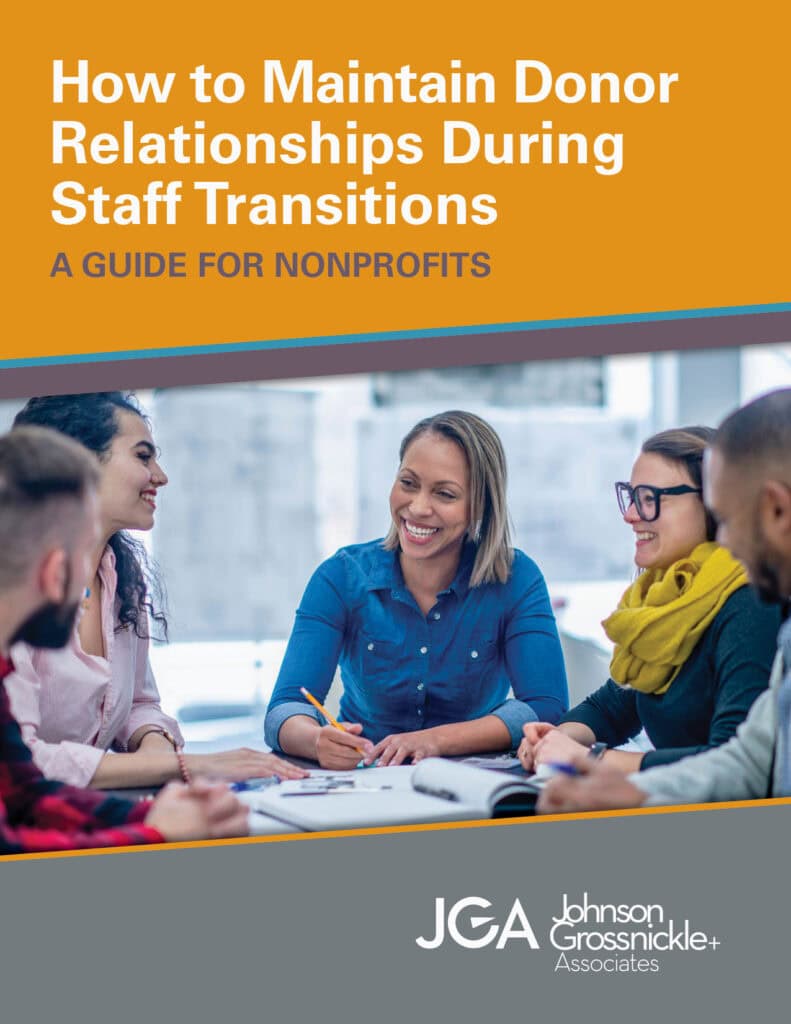Many nonprofits are facing a shortage of staff, and the issue seems to be hitting development teams most dramatically. According to a recent EAB (formerly Education Advisory Board) survey, a “great resignation” has occurred in fundraising over the past few years. The study found a 14 percent vacancy rate in higher education, for example, with fundraising staff the most likely to leave their positions among advancement departments. In addition, a wave of retirements among the Boomer generation is adding to the number of staff transitions. Job postings for advancement staff increased by 40% from 2017 to 2022, challenging development departments to continue building relationships and securing major philanthropic investments.
Your people are your greatest asset. As team members leave and you welcome new staff, your remaining team will need to be flexible and creative to maintain and grow important donor relationships.

We created a free e-book, How to Maintain Donor Relationships During Staff Transitions: A Guide for Nonprofits, to help nonprofits make the most of staff time and maintain strong relationships with donors, even during times of staff turnover.
If your organization is experiencing changes in your front-line fundraising staff, the guide includes the following tips and many more useful insights to help you minimize the impact on your donor relationships:
Keep Donors Engaged During Staff Transitions: Relieve some of the demands on front-line fundraising staff by exploring new ways of keeping donors engaged. This might include engaging other team members and exploring ways to use technology to send regular updates. Creating relationships with multiple team members deepens your donor relationships and maximizes the time major gift officers have to commit to cultivation and solicitation.
Help New Staff Members Build Relationships with Donors: Create a plan for transitioning donor relationships during changes in staff. You’ll need a process to share information and make introductions. This is also an important opportunity to review portfolio assignments.
Streamline and Customize Portfolios: Sharpen your focus to maximize your major gift officers’ time and resources and make sure they are engaging with and cultivating your most passionate supporters. Develop a portfolio management process that is efficient, flexible, and data-driven. The guide includes these 5 key questions to ask as you evaluate your portfolios.
Identify Your Best Prospects: Use the wealth of information in your database to identify the donors who are most likely to give. Data is an essential tool to help you make decisions about where to focus your resources and help you develop customized engagement strategies.
Develop an Ongoing Cultivation Strategy: As you streamline your portfolios, there will be many prospects you want to continue to engage. Develop a strong engagement strategy to help you cultivate those donors, even if they are not assigned to a portfolio.
Advocate for additional fundraising staff: Nonprofits often face the challenge of convincing board members and other stakeholders of the need to invest in fundraising staff. To provide an objective analysis of the investment in staff, highlight the return on investment (ROI) of adding more staff, as well as the impact of staff turnover on donor retention.
Maximizing the effectiveness of your fundraising staff during staff transitions is a complex and challenging task, yet it is essential to achieving your organization’s fundraising goals, and ultimately, fulfilling your mission. Download the free e-book for more guidance to help you meet these challenges. With these strategies and tips in mind, philanthropy can be the catalyst for your nonprofit to change the world.
